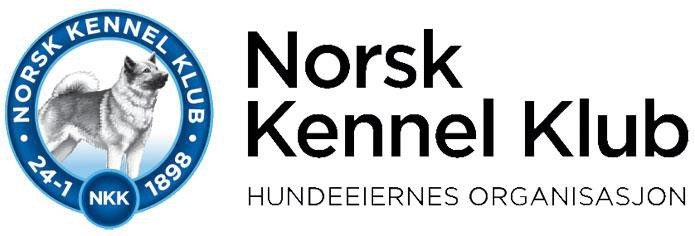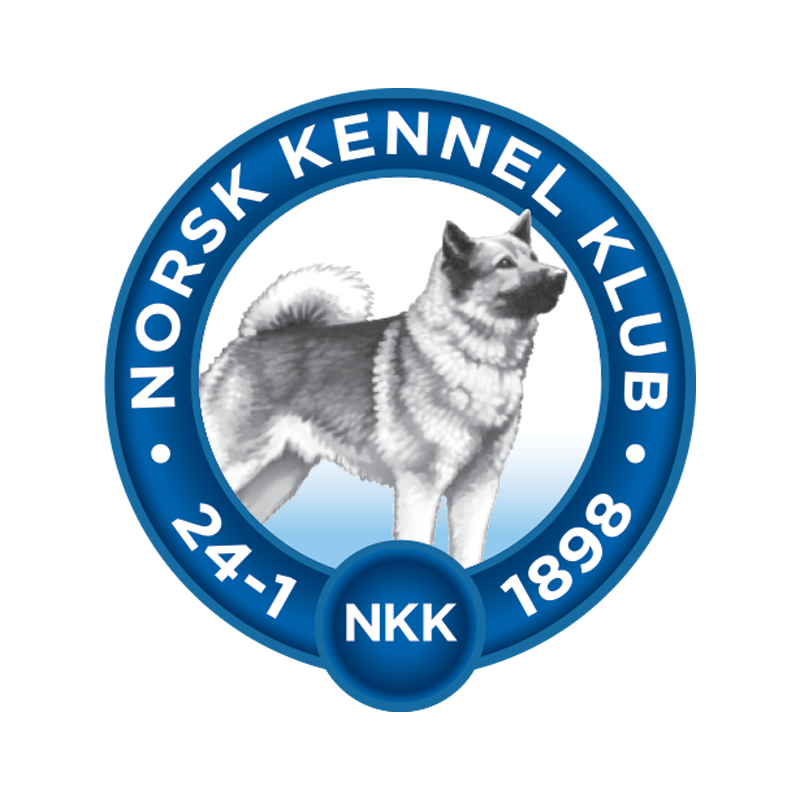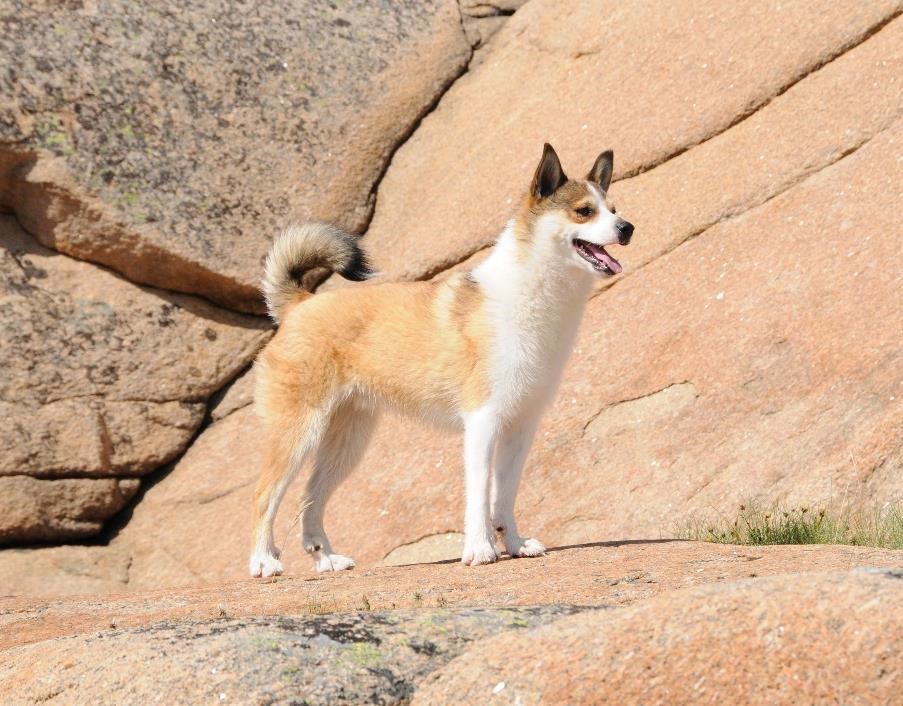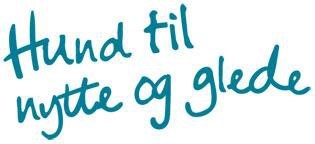See the PDF version
Many thanks to Kim Belamy from the NKK for sharing this information with DWN!
 Donate
DonateDid you find our content interesting or helpful? Help support the IPFD enhance health, well-being and welfare for dogs everywhere.

See the PDF version
Many thanks to Kim Belamy from the NKK for sharing this information with DWN!
The Norwegian Lundehund is a Norwegian native breed with a number of distinctive characteristics. Examples of distinctive traits are six toes on both front- and back legs, as well as unusual flexibility that allows the dogs to climb in harsh terrains. Originally, these dogs were used to hunt puffins, and The Norwegian Lundehund is the only breed known to retrieve live birds. The birds were harvested for their meat and down. Puffin hunting dates back 400 years and was important along the coast of northern parts of Norway.

A Norwegian Lundehund. Photographer: Vibeke Brath
The breed has suffered from several genetic bottlenecks, partly due to detrimental outbreaks of canine distemper virus. All current Norwegian Lundehunds originate from four individuals, who were also related to each other. Effects of limited genetic variance are prevalent in the breed. Small litter sizes and problems with reproduction occur frequently, with approximately 20% of litters producing only one puppy.
The effective population size, based on number of males and females used in breeding, is small (n<100). The average coefficient of inbreeding used to be very high, but has come down to 0.92 in 2012 as a result of breeders’ tireless efforts to reduce it. Even though the effective population size and average level of inbreeding is acceptable, the very low number of founders is probably an important cause of the signs of inbreeding depression seen in the breed.
The breed has few health problems and has an average life span of 9 years and 3 months. However, Norwegian Lundehunds are predisposed to intestinal lymphangiectasia (IL) and about 30% of the dogs die from the disease. IL is a gastrointestinal disease with symptoms like diarrhoea and vomiting, as well as heart failure with accumulating fluid in the abdomen and heart and lethargy. The typical age of onset is 4-5 years, but the disease may occur at any age. To some degree, it is possible to manage the disease with correct diet and medication and the disease is not always lethal. It is still considered a major welfare issue in the breed. There is reason to believe that the disease is hereditary, but no associated or causative gene has been detected. It is likely that the disease is polygenetic. The extremely low genetic diversity makes it almost impossible to breed away from the disease.
The Norwegian Kennel Club is currently working in collaboration with all breed clubs to create breed specific breeding strategies. In 2013, The Norwegian Lundehund Club created their breeding strategy, in which they explore various strategies to reduce problems with IL and low genetic diversity. They have now started an outcross project where Norwegian Lundehunds are mated to other breeds in order to increase the genetic variance, while still preserving the distinctive traits of the breed. The project is in collaboration with The Norwegian Kennel Club, The Norwegian University of Life Sciences, The Norwegian Genetic Resource Centre, NordGen and The Norwegian University of Science and Technology.
Balder is a handsome F1-male from a Norwegian Lundehund x Buhund cross. Photographer: Pål Berg
The Norwegian Lundehund crosses will be registered in a separate register and will only be included in the general Lundehund population after several generations and thorough evaluation. Based on advice from NordGen and The Norwegian Genetic Resource Centre three breeds were selected as good candidates for crosses; the Norwegian Buhund, the Islandic Sheepdog and the Norrbottenspitz. Geographic origin as well as morphology indicates that these breeds and Norwegian Lundehunds are to some degree related. One might argue that we are in fact reintroducing lost genetic variance, as opposed to introducing new breeds.
The plan is to mate two unrelated females from each of the three breeds to male Norwegian Lundehunds. The reason for using females from the other breeds is multifactorial. First, the other breeds are all larger than The Norwegian Lundehund and there are concerns that it will be hard for the small Lundehund female to carry and whelp a potentially large litter of large puppies. In addition, the use of larger females might contribute to larger litter sizes, which would provide more puppies for the program. Lastly, it is important to keep as many Lundehund females in the traditional Lundehund breeding program as possible.
Norwegian Lundehund female Shensi left and Norwegian Lundehund x Buhund cross Banzai right. Photographer: Jørn Olav Løkken
Both The Norwegian Lundehund Club and The Norwegian Kennel Club must approve each breeding. Chosen females may be atypical for their breed. It is considered an advantage if they have traits that resemble traits of The Norwegian Lundehund, for example that they are small, have similar coats or extra toes. They also need to be in good health and have sound temperaments. In collaboration with the Norwegian Kennel Club, The Norwegian Lundehund Club has created the following criteria for selection of breeding animals for the project:
Females from the three other breeds should:
• Be free from hip dysplasia
• Be free from hereditary eye disease
• Be free from patellar luxation
• Be free from other disease and disease among close relatives
• Have good fertility. It is preferred that the female has had at least one litter earlier. If not, fertility among relatives is considered.
• Have good temperaments
• Possibly other relevant examinations, depending on the breed. Norwegian Lundehunds used in the outcross program should:
• Be free from patellar luxation
• Not have had intestinal lymphangiectasia
• Have good general health
• Have good temperaments
• Preferably, they should have had at least one litter earlier.
The outcross puppies are thoroughly evaluated based on health, temperament and conformation. As many dogs as possible from the first generation (F1) will be bred, and only dogs that fail to meet health requirements will be excluded from the breeding program at this point.
Healthy F1-dogs are later bred to Norwegian Lundehunds to create F2. Selection of F2 dogs for breeding will be based not only on health, but also on breed characteristic traits like temperament and conformation. Continuous genetic analyses may be carried out to make sure genetic variance is not lost through this selection process.
The first litter of the project was born on the 12th of August 2014, between a Buhund female named Tyri and a Norwegian Lundehund male named Casper (Ulfrigga Lundes Qavi). The litter consisted of four females and two males. All the outcross puppies live in regular families.
The first puppies are now almost a year old and are doing well. The owners report that the dogs display characteristics from both breeds, and are very robust and energetic. The dogs are larger than most Norwegian Lundehunds and smaller than most Buhunds, as expected. All of them have extra toes on their back legs, but only one of the puppies have extra toes on her front legs.
F1-females at the annual show July 2015: Ruska, Hekla and Pippi. Photographer: Odd Reidar Gautun
At The Norwegian Lundehund Clubs annual gathering and show this July, the first outcross puppies were presented and evaluated.
Several other combinations for outcross matings have recently been approved.
For questions or further information, please contact the Norwegian Lundehund Club (http://www.lundehund.no/index.php/english2)

Besøksadresse: Nils Hansensvei 20
0667 Oslo
Postadresse: Boks 163, Bryn
0611 OSLO
Sentralbord: Telefaks:
21 600 900
21 600 901
Organisasjonsnummer: 937 125 577 MVA
Kontonummer: 1600.40.39983
Also see DWN's Norwegian Lundehund page for additional information.
Edited by Ann Milligan
By using this site, you agree to our Terms of Use.
Recommended Comments
There are no comments to display.
Join the conversation
You can post now and register later. If you have an account, sign in now to post with your account.
Note: Your post will require moderator approval before it will be visible.